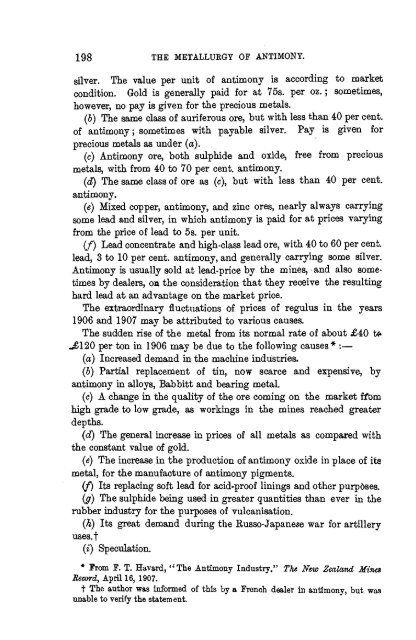antimony - Sciencemadness.org
antimony - Sciencemadness.org
antimony - Sciencemadness.org
You also want an ePaper? Increase the reach of your titles
YUMPU automatically turns print PDFs into web optimized ePapers that Google loves.
198 THE METALLURGY OF ANTIMONY.<br />
silver. The value per unit of <strong>antimony</strong> is according to market<br />
condition. Gold is generally paid for at 75s. per oz.; sometimes,<br />
however, no pay is given for the precious metals.<br />
(b) The same class of auriferous ore, but with less than 40 per cent,<br />
of <strong>antimony</strong>; sometimes with payable silver. Pay is given for<br />
precious metals as under (a).<br />
(c) Antimony ore, both sulphide and oxide, free from precious<br />
metals, with from 40 to 70 per cent, <strong>antimony</strong>.<br />
(d) The same class of ore as (c), but with less than 40 per cent,<br />
<strong>antimony</strong>.<br />
(e) Mixed copper, <strong>antimony</strong>, and zinc ores, nearly always carrying<br />
some lead and silver, in which <strong>antimony</strong> is paid for at prices varying<br />
from the price of lead to 5s. per unit.<br />
(/) Lead concentrate and high-class lead ore, with 40 to 60 per cent,<br />
lead, 3 to 10 per cent, <strong>antimony</strong>, and generally carrying some silver.<br />
Antimony is usually sold at lead-price by the mines, and also sometimes<br />
by dealers, on the consideration that they receive the resulting<br />
hard lead at an advantage on the market price.<br />
The extraordinary fluctuations of prices of regulus in the years<br />
1906 and 1907 may be attributed to various causes.<br />
The sudden rise of the metal from its normal rate of about £40 tk<br />
J>120 per ton in 1906 may be due to the following causes * :—<br />
(a) Increased demand in the machine industries.<br />
(b) Partial replacement of tin, now scarce and expensive, by<br />
<strong>antimony</strong> in alloys, Babbitt and bearing metal.<br />
(c) A change in the quality of the ore coming on the market ffom<br />
high grade to low grade, as workings in the mines reached greater<br />
depths.<br />
(d) The general increase in prices of all metals as compared with<br />
the constant value of gold.<br />
(e) The increase in the production of <strong>antimony</strong> oxide in place of its<br />
metal, for the manufacture of <strong>antimony</strong> pigments.<br />
(f) Its replacing soft lead for acid-proof linings and other purp6ses.<br />
(g) The sulphide being used in greater quantities than ever in the<br />
rubber industry for the purposes of vulcanisation.<br />
(h) Its great demand during the Russo-Japanese war for artillery<br />
uses.f<br />
(i) Speculation.<br />
* From F. T. Havard, "The Antimony Industry," The New Zealand Mines<br />
Record, April 16, 1907.<br />
t The author was informed of this by a French dealer in <strong>antimony</strong>, but was<br />
unable to verify the statement.
















